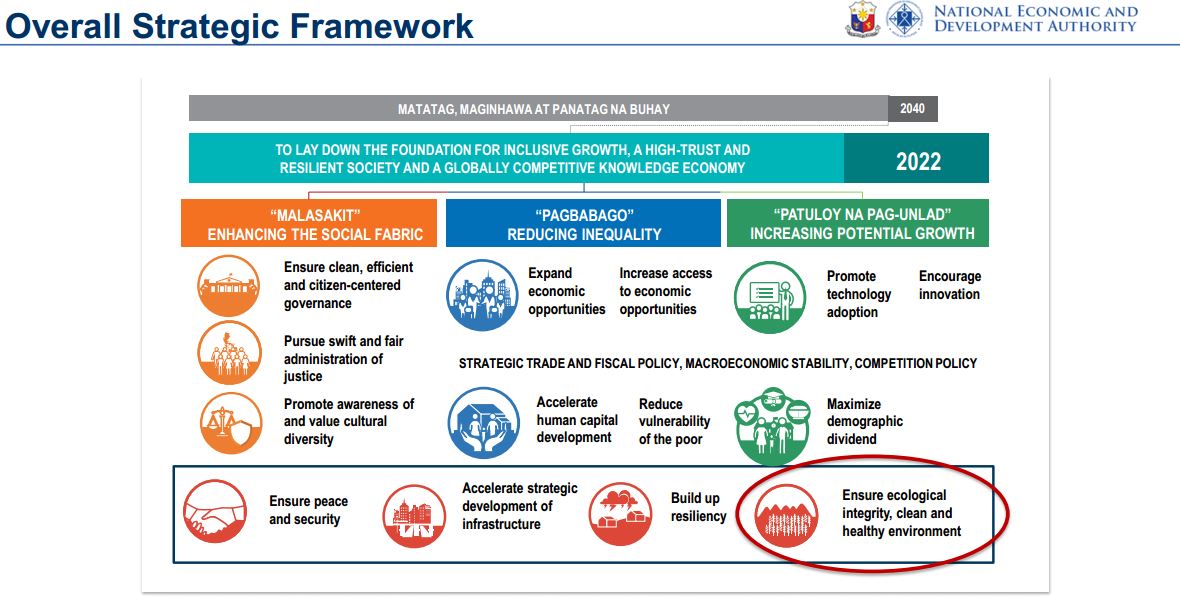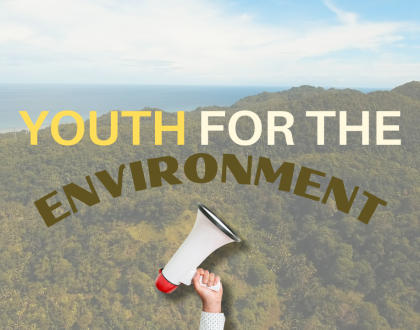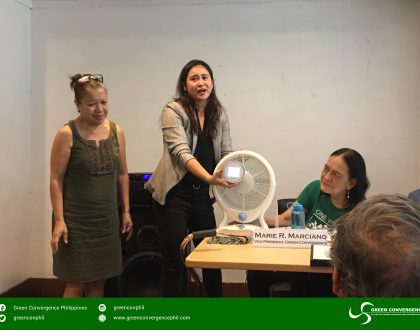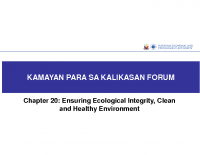Ensuring Ecological Integrity, Clean and Healthy Environment

Priority Strategies
Subsector Outcome 1: Sustained Functioning of Ecosystem Services
-
Intensify sustainable management of natural resources through adoption of ridge-to-reef approach and integrated area development
- Reverse the loss of forest cover through sustained rehabilitation of degraded forest lands including critical watersheds & major river basins
- Complete delineation of final forest limits and delineation/delimitation and zoning of watersheds and municipal waters
- Effectively manage the protected areas and enforce law against illegal trade of wildlife species
- Improve land administration and management (i.e. enhance access to land information, management of conflicts)
- Strengthen enforcement of laws and management of coastal and marine
areas - Complete Identify strategic economic zones for production of fish and
other marine products - Intensify research on the country’s biodiversity including terrestrial and
coastal and marine habitats and resources - Improve the management of priority inland wetlands and caves
- Identify innovative sustainable financing schemes for resource
management - Improve self-sufficiency in the country’s wood and non-timber requirements and making the forestry sector a significant contributor to the economy
-
Expand development of resource-based enterprises/industries
- Promote sustainable forest-based (timber and non-timber) and sustainable marine-based industries [refer to AFF and I&S Chapters]
- Develop system for access and benefit sharing of wealth from genetic resources
- Improve system of collection and increase share from appropriate fees and fines in areas covered by tenure (e.g. foreshore lease areas, SAPA, etc)
- Promotion and development of ecotourism and cultural sites [refer to AFF, I&S, and Cultural Awareness Chapters]
-
Mainstream ecosystem values into national and local development planning
- Develop policy for Payments for Ecosystem Services (PES) and polluters pay
- Institutionalization of natural resources monitoring
system and environment and natural resources
accounting
Subsector Outcome 2: Improved Environmental Quality
-
Strengthen enforcement of environmental laws
-
-
Air Quality Management
- Promote environmentally-sustainable transport including clean fuels and mass transport system
- Strengthen enforcement of anti-smoke belching campaign and vehicle emission testing
- Increase quantity and efficiency of air quality monitoring stations
-
Water Quality Management
- Improve wastewater management by increasing the number of domestic and industrial wastewater treatment facilities in water districts/LGUs
- Identify pollutants in priority river systems and implement appropriate management interventions
-
Land Quality Management
- Promote sustainable land management (SLM) to contribute to land degradation neutrality (i.e. soil fertility, soil & water conservation technologies, etc.)
- Improve management of wastes including solid, toxic and hazardous wastes
- Transform abandoned mines/mined-out areas into final land use beneficial to communities through implementation of environmental
management plans
-
-
Promote Sustainable Consumption and Production (SCP)
- Establish sustainable market for recyclables and recycled products;
- Develop, promote and transfer cleaner production technologies, including water and energy-efficient practices (e.g. rainwater catchment facility, cleaner fuels and engine, energy efficient facilities/green buildings) [cross refer to I&S, Infrastructure, STI Chapters]
- Strengthen certification and establish information systems for green products and services
- Promote green procurement in both private and public sectors;
- Promote environmentally-sustainable transport (EST) including mass transport system [cross refer to I&S, Infrastructure, STI Chapters]
-
Subsector Outcome 3: Increased adaptive capacities and resilience of ecosystems
-
Strengthen implementation of CCA and DRR, particularly at the local level across sectors.
- Develop, maintain and make available and accessible climate and geospatial information and services, including integrated risk information system in a standardized format/scale
- Develop data protocol to facilitate access and sharing of available scientific researches/studies, geospatial information and climate projection
- Continue to mainstream CC and DRRM in national and local development plans and policies and education system (cut across Chapters of the PDP)
- Promote climate-resilient structures and designs following established measures and standards by DPWH, HLURB, DILG, DSWD and other government agencies (refer to infrastructure Development, AFF, I&S, Building Resiliency and Social Protection Chapters)
- Identify technological and research priorities and capacity needs on CC and DRRM (refer to Expanding Economic Opportunities in Industry, STI, and Infrastructure Development Chapters)
- Strengthen access to existing CC and DRRM financing and risk transfer mechanisms including promotion campaign (refer to Social Protection Chapter)
- Promote preparation of business continuity planning (refer to I&S Chapter)
-
Strengthen implementation of response, recovery and rehabilitation efforts.
- Strengthen mechanism to conduct the Post/Rapid Disaster Needs Assessment (P/RDNA)
- Revisit existing policies on post disaster housing and resettlement programs including those related to land development (refer to Social Protection Chapter)
-
Strengthen Monitoring and Evaluation of effectiveness of CC and DRRM actions
- Identification of more appropriate indicator to measure adaptive capacity and resiliency (including indicator of resiliency of natural resources/ecosystems) vis-à-vis SDGs and SFDRR (cut across Chapters of the PDP)
- Development of database that would measure emission reduction per sector (including aviation and maritime)
-
Recommended Posts

Kabataan Para sa Kalikasan!
February 26, 2021

Environmental Forum: ‘Kailangan pa rin ang green spaces sa urban area’
November 23, 2020

Green Convergence to LGUs: ‘Invest in green spaces!’
October 23, 2019

